Change Management: Theories, Strategies, and Implementation
VerifiedAdded on 2022/12/27
|14
|4048
|1
Essay
AI Summary
This essay delves into the multifaceted realm of change management within organizations, exploring its inevitability and significance in a dynamic business environment. It analyzes the causes of organizational change, including environmental and internal dynamics, and emphasizes the crucial role of management in implementing successful transformations. The essay defines organizational change, differentiating between evolutionary and revolutionary approaches, and discusses models like Kurt Lewin's and Kotter's. It also highlights the importance of effective communication and employee engagement during change initiatives, while acknowledging potential challenges and pitfalls. The paper offers insights into change management strategies and provides a comprehensive overview of the subject.
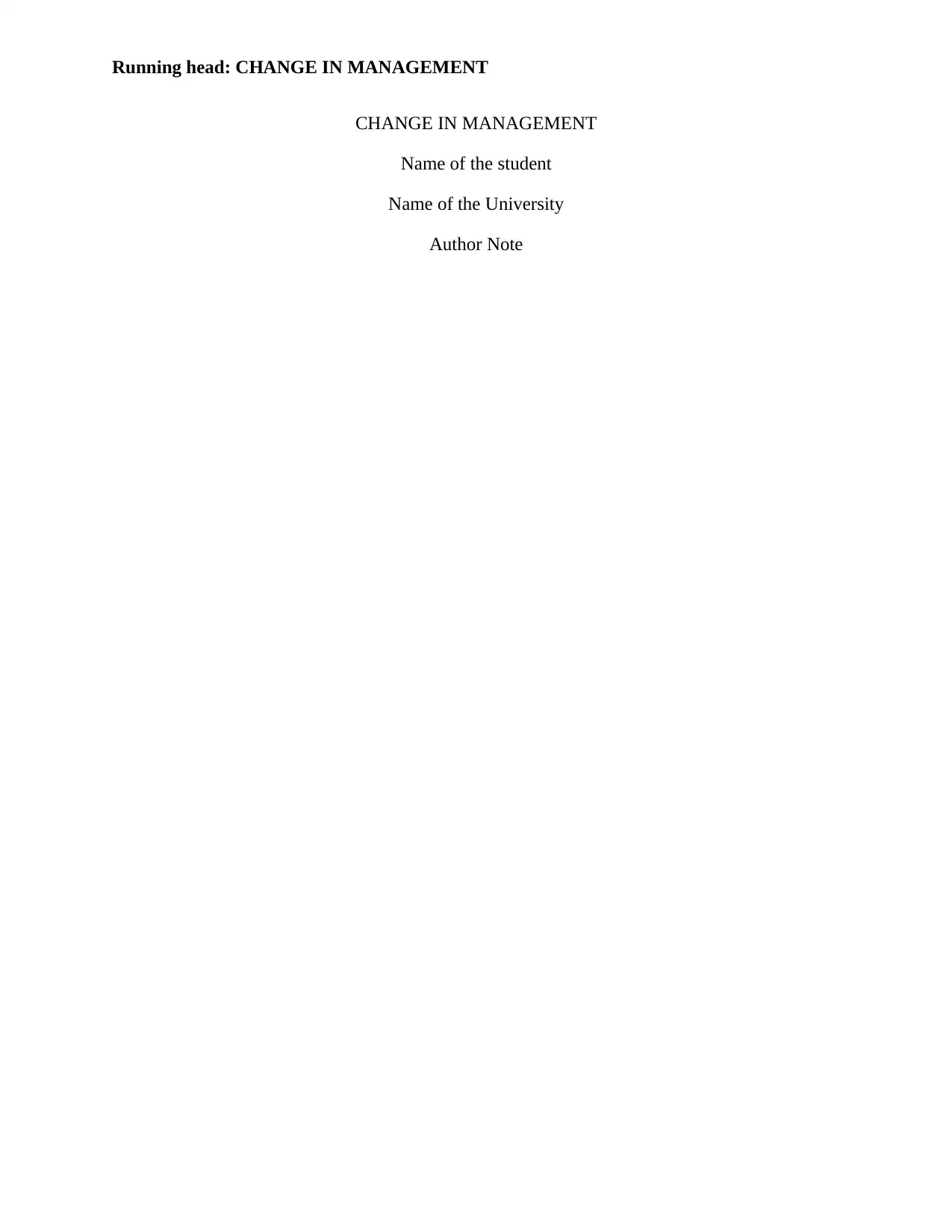
Running head: CHANGE IN MANAGEMENT
CHANGE IN MANAGEMENT
Name of the student
Name of the University
Author Note
CHANGE IN MANAGEMENT
Name of the student
Name of the University
Author Note
Paraphrase This Document
Need a fresh take? Get an instant paraphrase of this document with our AI Paraphraser
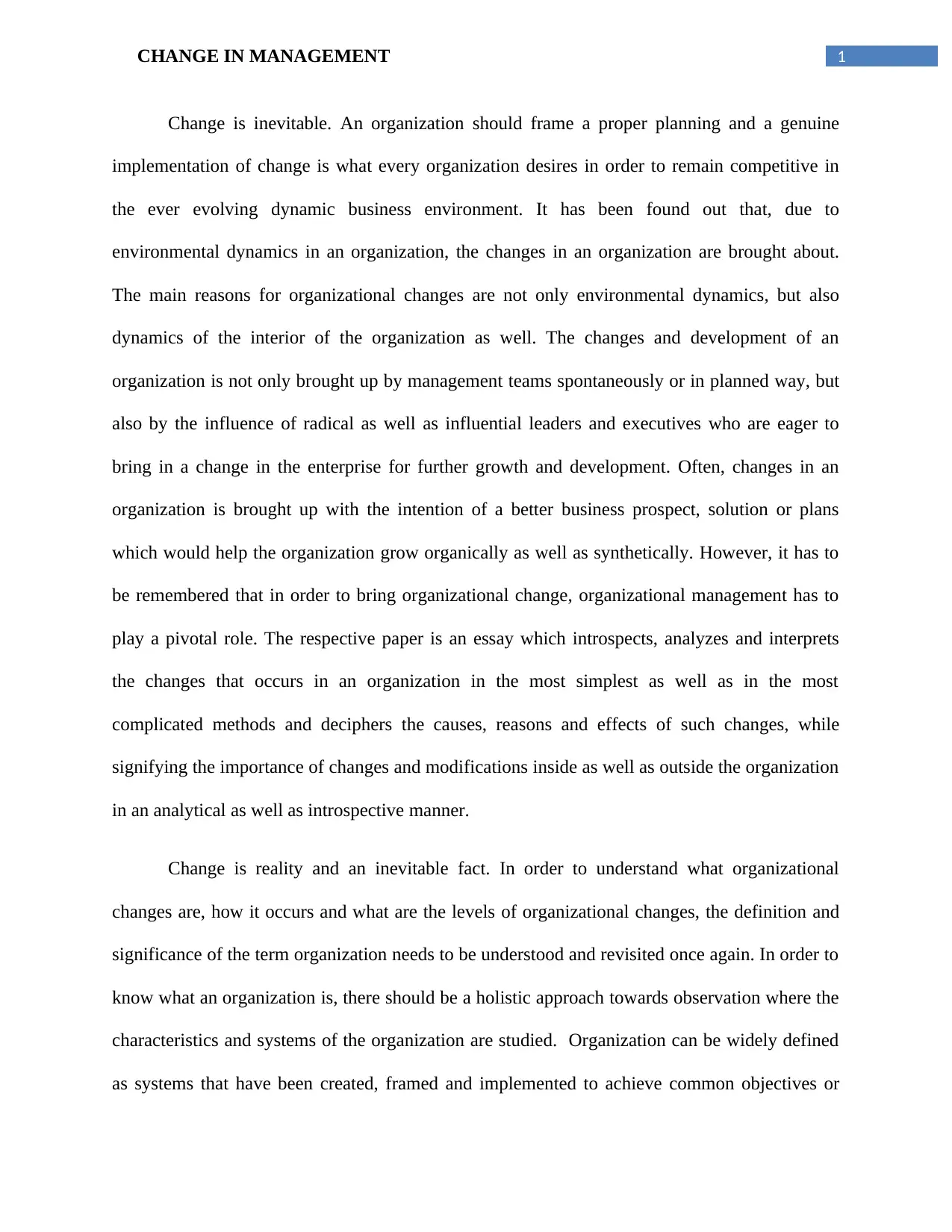
1CHANGE IN MANAGEMENT
Change is inevitable. An organization should frame a proper planning and a genuine
implementation of change is what every organization desires in order to remain competitive in
the ever evolving dynamic business environment. It has been found out that, due to
environmental dynamics in an organization, the changes in an organization are brought about.
The main reasons for organizational changes are not only environmental dynamics, but also
dynamics of the interior of the organization as well. The changes and development of an
organization is not only brought up by management teams spontaneously or in planned way, but
also by the influence of radical as well as influential leaders and executives who are eager to
bring in a change in the enterprise for further growth and development. Often, changes in an
organization is brought up with the intention of a better business prospect, solution or plans
which would help the organization grow organically as well as synthetically. However, it has to
be remembered that in order to bring organizational change, organizational management has to
play a pivotal role. The respective paper is an essay which introspects, analyzes and interprets
the changes that occurs in an organization in the most simplest as well as in the most
complicated methods and deciphers the causes, reasons and effects of such changes, while
signifying the importance of changes and modifications inside as well as outside the organization
in an analytical as well as introspective manner.
Change is reality and an inevitable fact. In order to understand what organizational
changes are, how it occurs and what are the levels of organizational changes, the definition and
significance of the term organization needs to be understood and revisited once again. In order to
know what an organization is, there should be a holistic approach towards observation where the
characteristics and systems of the organization are studied. Organization can be widely defined
as systems that have been created, framed and implemented to achieve common objectives or
Change is inevitable. An organization should frame a proper planning and a genuine
implementation of change is what every organization desires in order to remain competitive in
the ever evolving dynamic business environment. It has been found out that, due to
environmental dynamics in an organization, the changes in an organization are brought about.
The main reasons for organizational changes are not only environmental dynamics, but also
dynamics of the interior of the organization as well. The changes and development of an
organization is not only brought up by management teams spontaneously or in planned way, but
also by the influence of radical as well as influential leaders and executives who are eager to
bring in a change in the enterprise for further growth and development. Often, changes in an
organization is brought up with the intention of a better business prospect, solution or plans
which would help the organization grow organically as well as synthetically. However, it has to
be remembered that in order to bring organizational change, organizational management has to
play a pivotal role. The respective paper is an essay which introspects, analyzes and interprets
the changes that occurs in an organization in the most simplest as well as in the most
complicated methods and deciphers the causes, reasons and effects of such changes, while
signifying the importance of changes and modifications inside as well as outside the organization
in an analytical as well as introspective manner.
Change is reality and an inevitable fact. In order to understand what organizational
changes are, how it occurs and what are the levels of organizational changes, the definition and
significance of the term organization needs to be understood and revisited once again. In order to
know what an organization is, there should be a holistic approach towards observation where the
characteristics and systems of the organization are studied. Organization can be widely defined
as systems that have been created, framed and implemented to achieve common objectives or
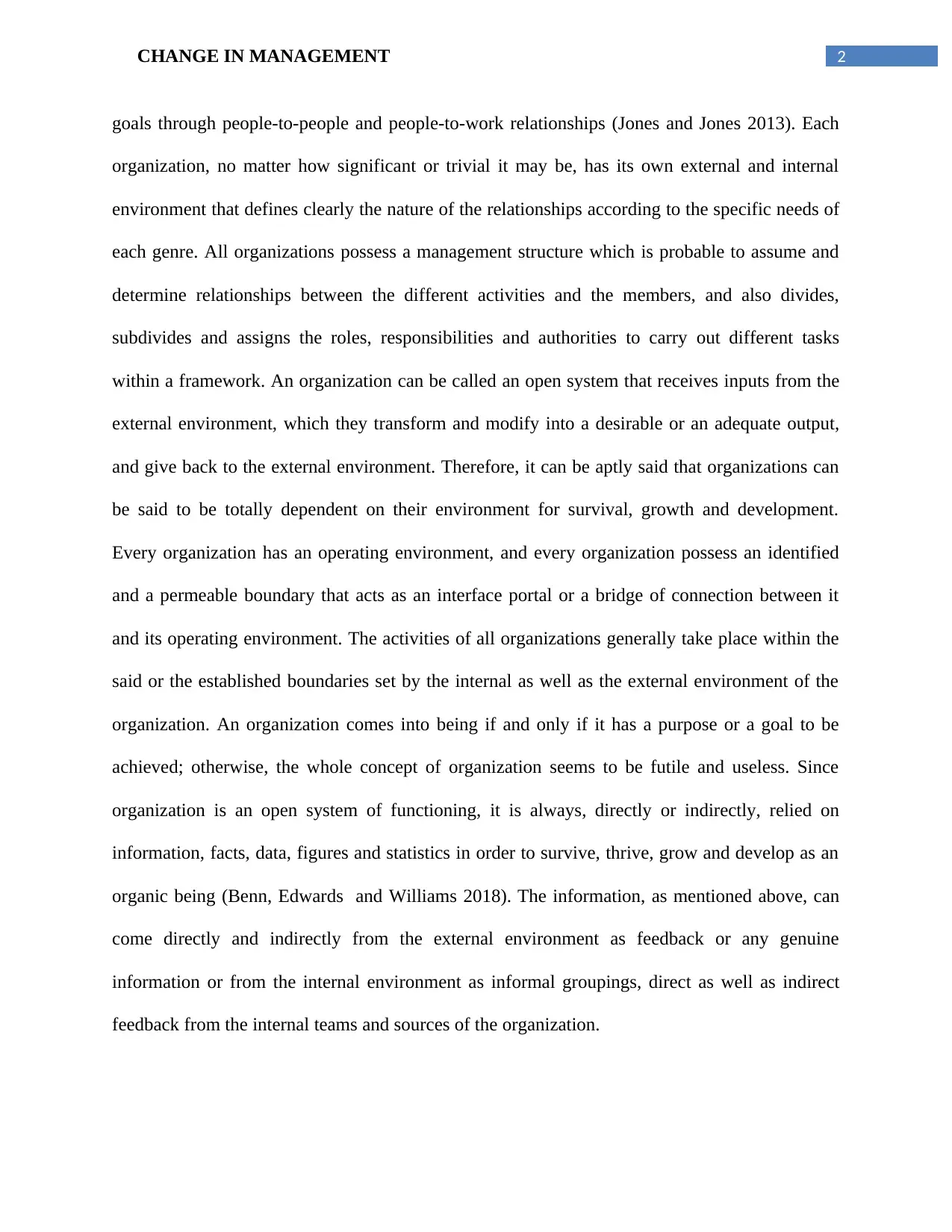
2CHANGE IN MANAGEMENT
goals through people-to-people and people-to-work relationships (Jones and Jones 2013). Each
organization, no matter how significant or trivial it may be, has its own external and internal
environment that defines clearly the nature of the relationships according to the specific needs of
each genre. All organizations possess a management structure which is probable to assume and
determine relationships between the different activities and the members, and also divides,
subdivides and assigns the roles, responsibilities and authorities to carry out different tasks
within a framework. An organization can be called an open system that receives inputs from the
external environment, which they transform and modify into a desirable or an adequate output,
and give back to the external environment. Therefore, it can be aptly said that organizations can
be said to be totally dependent on their environment for survival, growth and development.
Every organization has an operating environment, and every organization possess an identified
and a permeable boundary that acts as an interface portal or a bridge of connection between it
and its operating environment. The activities of all organizations generally take place within the
said or the established boundaries set by the internal as well as the external environment of the
organization. An organization comes into being if and only if it has a purpose or a goal to be
achieved; otherwise, the whole concept of organization seems to be futile and useless. Since
organization is an open system of functioning, it is always, directly or indirectly, relied on
information, facts, data, figures and statistics in order to survive, thrive, grow and develop as an
organic being (Benn, Edwards and Williams 2018). The information, as mentioned above, can
come directly and indirectly from the external environment as feedback or any genuine
information or from the internal environment as informal groupings, direct as well as indirect
feedback from the internal teams and sources of the organization.
goals through people-to-people and people-to-work relationships (Jones and Jones 2013). Each
organization, no matter how significant or trivial it may be, has its own external and internal
environment that defines clearly the nature of the relationships according to the specific needs of
each genre. All organizations possess a management structure which is probable to assume and
determine relationships between the different activities and the members, and also divides,
subdivides and assigns the roles, responsibilities and authorities to carry out different tasks
within a framework. An organization can be called an open system that receives inputs from the
external environment, which they transform and modify into a desirable or an adequate output,
and give back to the external environment. Therefore, it can be aptly said that organizations can
be said to be totally dependent on their environment for survival, growth and development.
Every organization has an operating environment, and every organization possess an identified
and a permeable boundary that acts as an interface portal or a bridge of connection between it
and its operating environment. The activities of all organizations generally take place within the
said or the established boundaries set by the internal as well as the external environment of the
organization. An organization comes into being if and only if it has a purpose or a goal to be
achieved; otherwise, the whole concept of organization seems to be futile and useless. Since
organization is an open system of functioning, it is always, directly or indirectly, relied on
information, facts, data, figures and statistics in order to survive, thrive, grow and develop as an
organic being (Benn, Edwards and Williams 2018). The information, as mentioned above, can
come directly and indirectly from the external environment as feedback or any genuine
information or from the internal environment as informal groupings, direct as well as indirect
feedback from the internal teams and sources of the organization.
⊘ This is a preview!⊘
Do you want full access?
Subscribe today to unlock all pages.

Trusted by 1+ million students worldwide
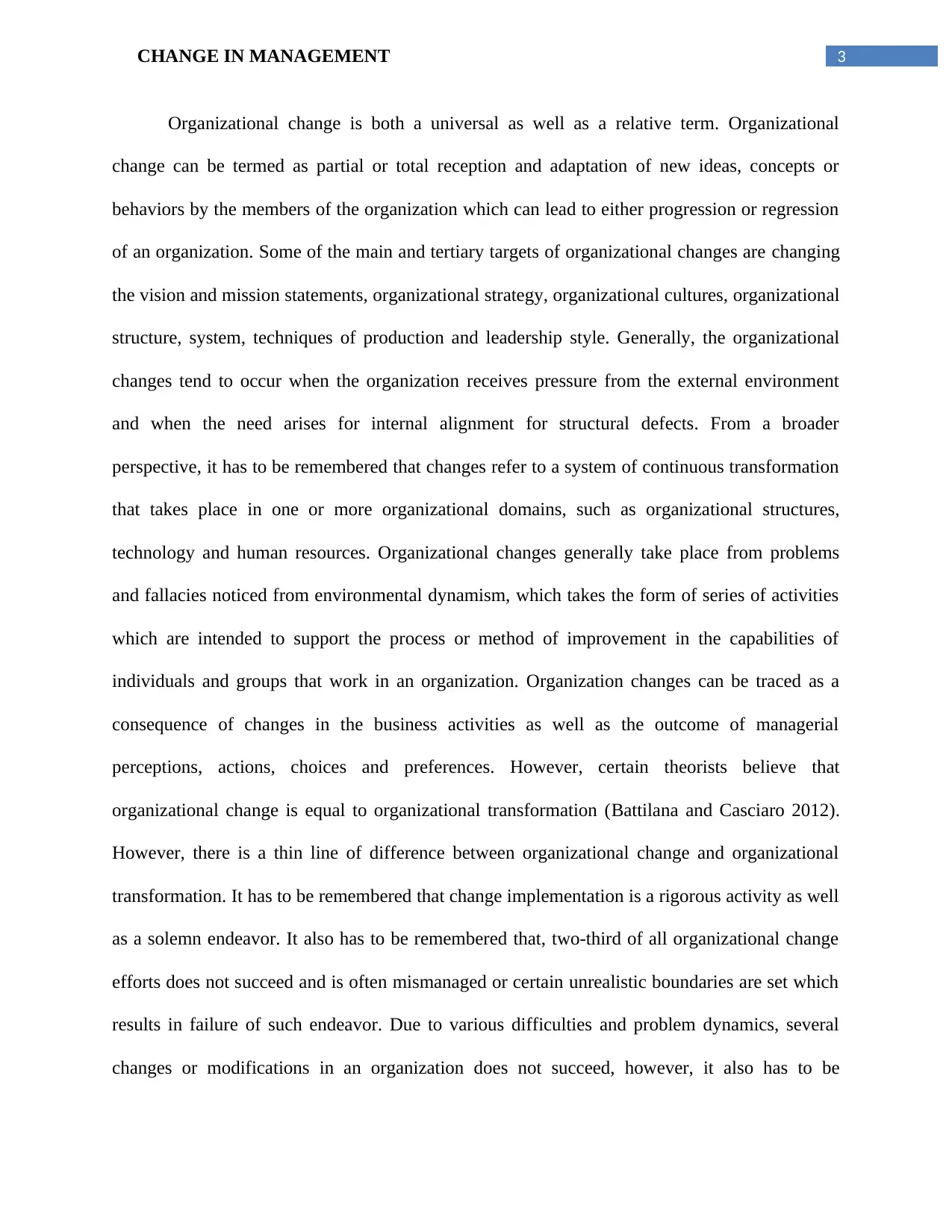
3CHANGE IN MANAGEMENT
Organizational change is both a universal as well as a relative term. Organizational
change can be termed as partial or total reception and adaptation of new ideas, concepts or
behaviors by the members of the organization which can lead to either progression or regression
of an organization. Some of the main and tertiary targets of organizational changes are changing
the vision and mission statements, organizational strategy, organizational cultures, organizational
structure, system, techniques of production and leadership style. Generally, the organizational
changes tend to occur when the organization receives pressure from the external environment
and when the need arises for internal alignment for structural defects. From a broader
perspective, it has to be remembered that changes refer to a system of continuous transformation
that takes place in one or more organizational domains, such as organizational structures,
technology and human resources. Organizational changes generally take place from problems
and fallacies noticed from environmental dynamism, which takes the form of series of activities
which are intended to support the process or method of improvement in the capabilities of
individuals and groups that work in an organization. Organization changes can be traced as a
consequence of changes in the business activities as well as the outcome of managerial
perceptions, actions, choices and preferences. However, certain theorists believe that
organizational change is equal to organizational transformation (Battilana and Casciaro 2012).
However, there is a thin line of difference between organizational change and organizational
transformation. It has to be remembered that change implementation is a rigorous activity as well
as a solemn endeavor. It also has to be remembered that, two-third of all organizational change
efforts does not succeed and is often mismanaged or certain unrealistic boundaries are set which
results in failure of such endeavor. Due to various difficulties and problem dynamics, several
changes or modifications in an organization does not succeed, however, it also has to be
Organizational change is both a universal as well as a relative term. Organizational
change can be termed as partial or total reception and adaptation of new ideas, concepts or
behaviors by the members of the organization which can lead to either progression or regression
of an organization. Some of the main and tertiary targets of organizational changes are changing
the vision and mission statements, organizational strategy, organizational cultures, organizational
structure, system, techniques of production and leadership style. Generally, the organizational
changes tend to occur when the organization receives pressure from the external environment
and when the need arises for internal alignment for structural defects. From a broader
perspective, it has to be remembered that changes refer to a system of continuous transformation
that takes place in one or more organizational domains, such as organizational structures,
technology and human resources. Organizational changes generally take place from problems
and fallacies noticed from environmental dynamism, which takes the form of series of activities
which are intended to support the process or method of improvement in the capabilities of
individuals and groups that work in an organization. Organization changes can be traced as a
consequence of changes in the business activities as well as the outcome of managerial
perceptions, actions, choices and preferences. However, certain theorists believe that
organizational change is equal to organizational transformation (Battilana and Casciaro 2012).
However, there is a thin line of difference between organizational change and organizational
transformation. It has to be remembered that change implementation is a rigorous activity as well
as a solemn endeavor. It also has to be remembered that, two-third of all organizational change
efforts does not succeed and is often mismanaged or certain unrealistic boundaries are set which
results in failure of such endeavor. Due to various difficulties and problem dynamics, several
changes or modifications in an organization does not succeed, however, it also has to be
Paraphrase This Document
Need a fresh take? Get an instant paraphrase of this document with our AI Paraphraser
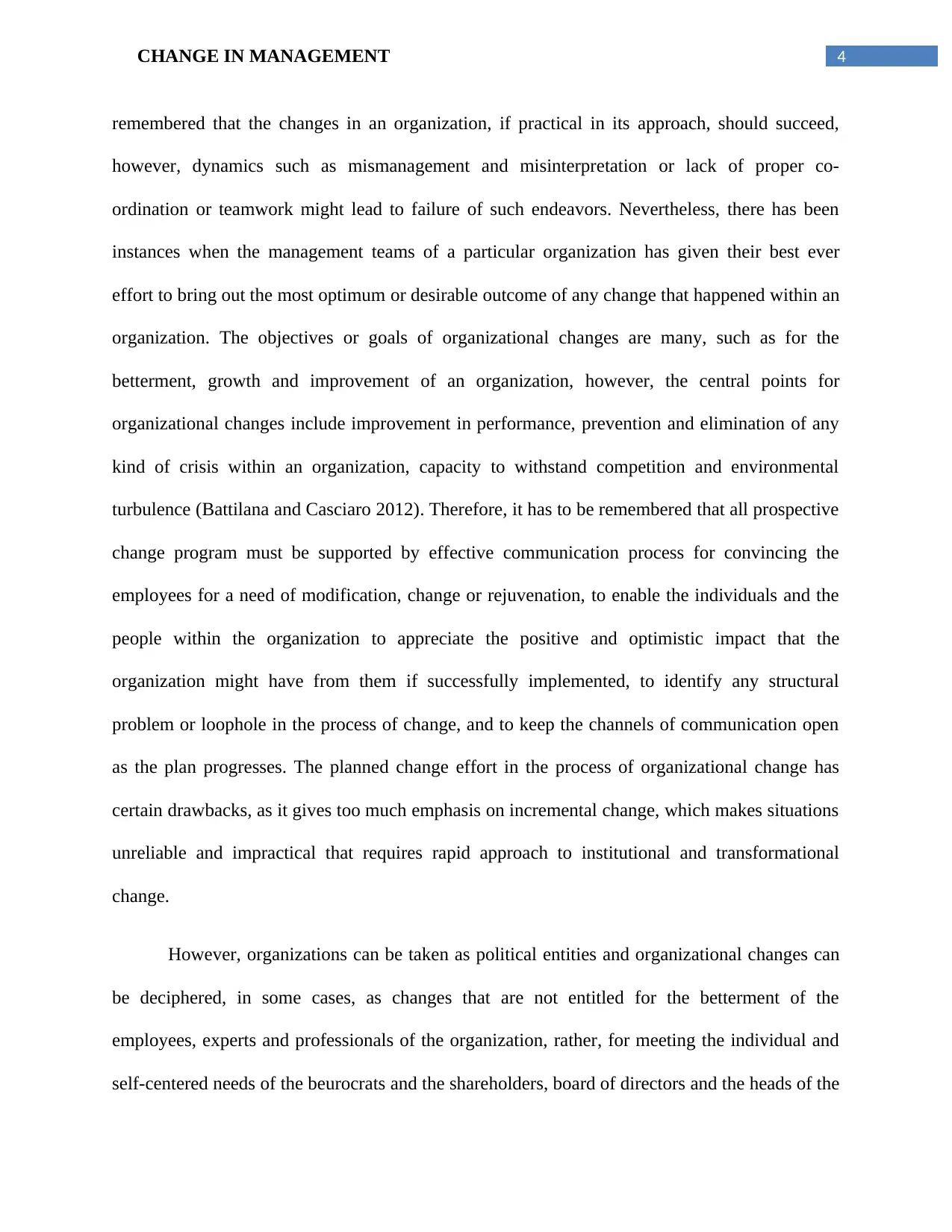
4CHANGE IN MANAGEMENT
remembered that the changes in an organization, if practical in its approach, should succeed,
however, dynamics such as mismanagement and misinterpretation or lack of proper co-
ordination or teamwork might lead to failure of such endeavors. Nevertheless, there has been
instances when the management teams of a particular organization has given their best ever
effort to bring out the most optimum or desirable outcome of any change that happened within an
organization. The objectives or goals of organizational changes are many, such as for the
betterment, growth and improvement of an organization, however, the central points for
organizational changes include improvement in performance, prevention and elimination of any
kind of crisis within an organization, capacity to withstand competition and environmental
turbulence (Battilana and Casciaro 2012). Therefore, it has to be remembered that all prospective
change program must be supported by effective communication process for convincing the
employees for a need of modification, change or rejuvenation, to enable the individuals and the
people within the organization to appreciate the positive and optimistic impact that the
organization might have from them if successfully implemented, to identify any structural
problem or loophole in the process of change, and to keep the channels of communication open
as the plan progresses. The planned change effort in the process of organizational change has
certain drawbacks, as it gives too much emphasis on incremental change, which makes situations
unreliable and impractical that requires rapid approach to institutional and transformational
change.
However, organizations can be taken as political entities and organizational changes can
be deciphered, in some cases, as changes that are not entitled for the betterment of the
employees, experts and professionals of the organization, rather, for meeting the individual and
self-centered needs of the beurocrats and the shareholders, board of directors and the heads of the
remembered that the changes in an organization, if practical in its approach, should succeed,
however, dynamics such as mismanagement and misinterpretation or lack of proper co-
ordination or teamwork might lead to failure of such endeavors. Nevertheless, there has been
instances when the management teams of a particular organization has given their best ever
effort to bring out the most optimum or desirable outcome of any change that happened within an
organization. The objectives or goals of organizational changes are many, such as for the
betterment, growth and improvement of an organization, however, the central points for
organizational changes include improvement in performance, prevention and elimination of any
kind of crisis within an organization, capacity to withstand competition and environmental
turbulence (Battilana and Casciaro 2012). Therefore, it has to be remembered that all prospective
change program must be supported by effective communication process for convincing the
employees for a need of modification, change or rejuvenation, to enable the individuals and the
people within the organization to appreciate the positive and optimistic impact that the
organization might have from them if successfully implemented, to identify any structural
problem or loophole in the process of change, and to keep the channels of communication open
as the plan progresses. The planned change effort in the process of organizational change has
certain drawbacks, as it gives too much emphasis on incremental change, which makes situations
unreliable and impractical that requires rapid approach to institutional and transformational
change.
However, organizations can be taken as political entities and organizational changes can
be deciphered, in some cases, as changes that are not entitled for the betterment of the
employees, experts and professionals of the organization, rather, for meeting the individual and
self-centered needs of the beurocrats and the shareholders, board of directors and the heads of the
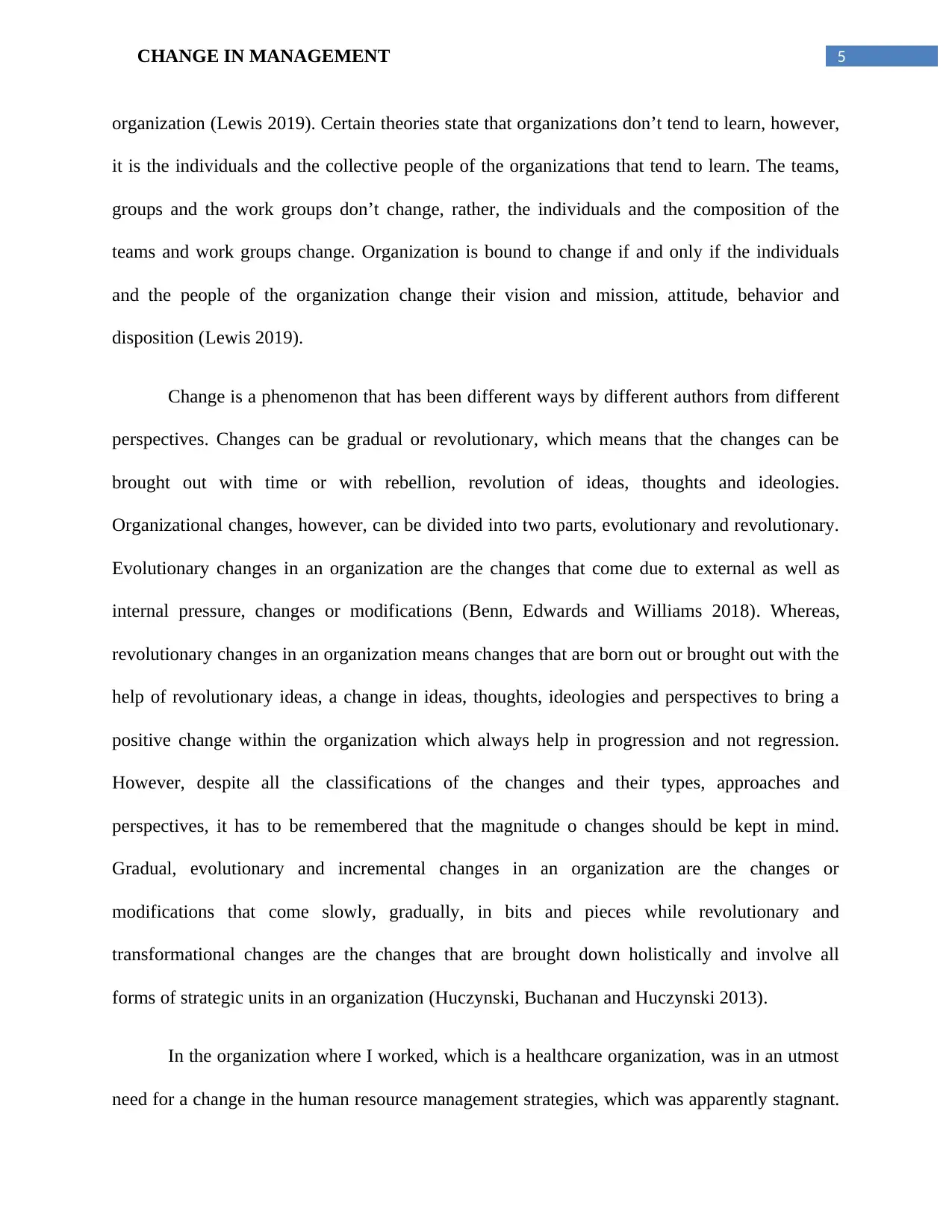
5CHANGE IN MANAGEMENT
organization (Lewis 2019). Certain theories state that organizations don’t tend to learn, however,
it is the individuals and the collective people of the organizations that tend to learn. The teams,
groups and the work groups don’t change, rather, the individuals and the composition of the
teams and work groups change. Organization is bound to change if and only if the individuals
and the people of the organization change their vision and mission, attitude, behavior and
disposition (Lewis 2019).
Change is a phenomenon that has been different ways by different authors from different
perspectives. Changes can be gradual or revolutionary, which means that the changes can be
brought out with time or with rebellion, revolution of ideas, thoughts and ideologies.
Organizational changes, however, can be divided into two parts, evolutionary and revolutionary.
Evolutionary changes in an organization are the changes that come due to external as well as
internal pressure, changes or modifications (Benn, Edwards and Williams 2018). Whereas,
revolutionary changes in an organization means changes that are born out or brought out with the
help of revolutionary ideas, a change in ideas, thoughts, ideologies and perspectives to bring a
positive change within the organization which always help in progression and not regression.
However, despite all the classifications of the changes and their types, approaches and
perspectives, it has to be remembered that the magnitude o changes should be kept in mind.
Gradual, evolutionary and incremental changes in an organization are the changes or
modifications that come slowly, gradually, in bits and pieces while revolutionary and
transformational changes are the changes that are brought down holistically and involve all
forms of strategic units in an organization (Huczynski, Buchanan and Huczynski 2013).
In the organization where I worked, which is a healthcare organization, was in an utmost
need for a change in the human resource management strategies, which was apparently stagnant.
organization (Lewis 2019). Certain theories state that organizations don’t tend to learn, however,
it is the individuals and the collective people of the organizations that tend to learn. The teams,
groups and the work groups don’t change, rather, the individuals and the composition of the
teams and work groups change. Organization is bound to change if and only if the individuals
and the people of the organization change their vision and mission, attitude, behavior and
disposition (Lewis 2019).
Change is a phenomenon that has been different ways by different authors from different
perspectives. Changes can be gradual or revolutionary, which means that the changes can be
brought out with time or with rebellion, revolution of ideas, thoughts and ideologies.
Organizational changes, however, can be divided into two parts, evolutionary and revolutionary.
Evolutionary changes in an organization are the changes that come due to external as well as
internal pressure, changes or modifications (Benn, Edwards and Williams 2018). Whereas,
revolutionary changes in an organization means changes that are born out or brought out with the
help of revolutionary ideas, a change in ideas, thoughts, ideologies and perspectives to bring a
positive change within the organization which always help in progression and not regression.
However, despite all the classifications of the changes and their types, approaches and
perspectives, it has to be remembered that the magnitude o changes should be kept in mind.
Gradual, evolutionary and incremental changes in an organization are the changes or
modifications that come slowly, gradually, in bits and pieces while revolutionary and
transformational changes are the changes that are brought down holistically and involve all
forms of strategic units in an organization (Huczynski, Buchanan and Huczynski 2013).
In the organization where I worked, which is a healthcare organization, was in an utmost
need for a change in the human resource management strategies, which was apparently stagnant.
⊘ This is a preview!⊘
Do you want full access?
Subscribe today to unlock all pages.

Trusted by 1+ million students worldwide
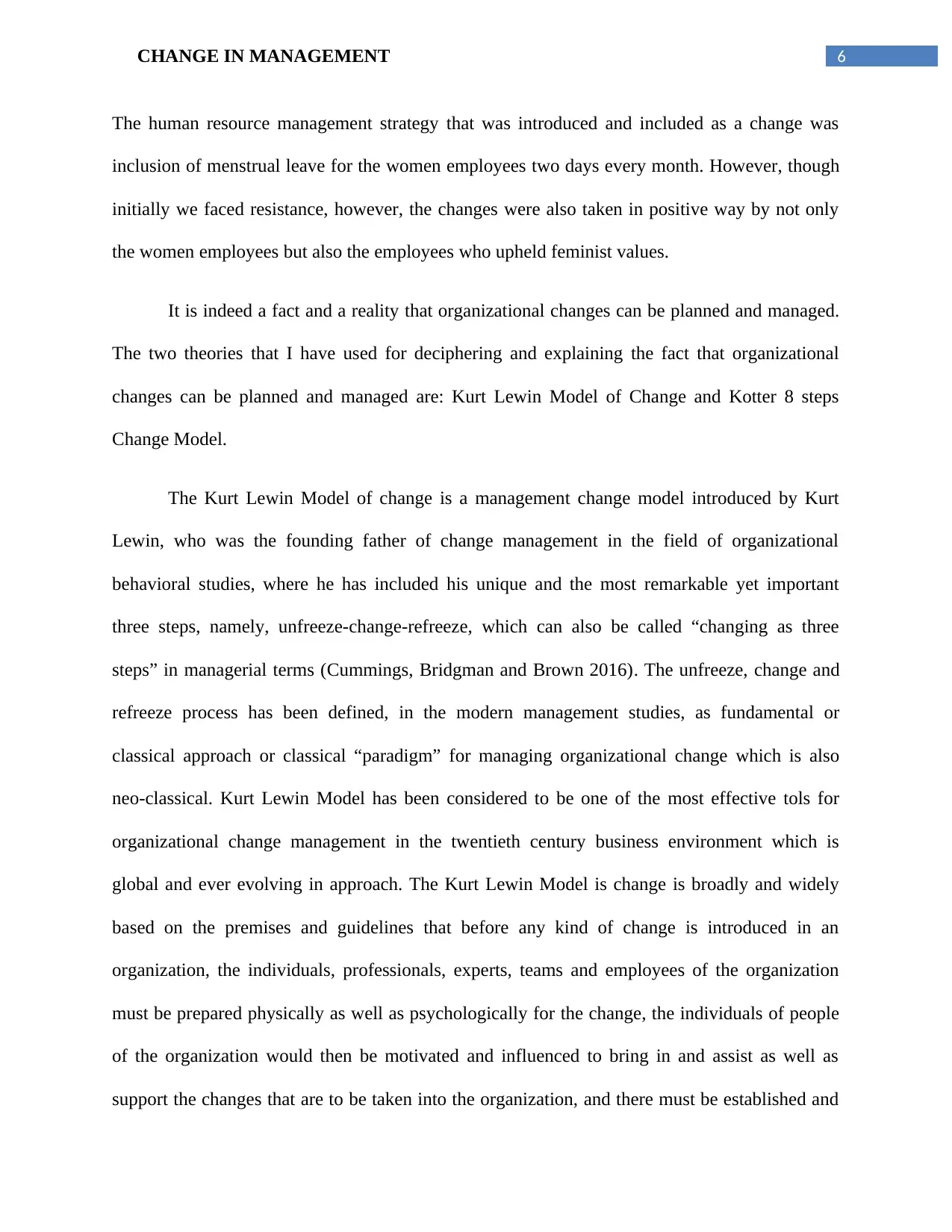
6CHANGE IN MANAGEMENT
The human resource management strategy that was introduced and included as a change was
inclusion of menstrual leave for the women employees two days every month. However, though
initially we faced resistance, however, the changes were also taken in positive way by not only
the women employees but also the employees who upheld feminist values.
It is indeed a fact and a reality that organizational changes can be planned and managed.
The two theories that I have used for deciphering and explaining the fact that organizational
changes can be planned and managed are: Kurt Lewin Model of Change and Kotter 8 steps
Change Model.
The Kurt Lewin Model of change is a management change model introduced by Kurt
Lewin, who was the founding father of change management in the field of organizational
behavioral studies, where he has included his unique and the most remarkable yet important
three steps, namely, unfreeze-change-refreeze, which can also be called “changing as three
steps” in managerial terms (Cummings, Bridgman and Brown 2016). The unfreeze, change and
refreeze process has been defined, in the modern management studies, as fundamental or
classical approach or classical “paradigm” for managing organizational change which is also
neo-classical. Kurt Lewin Model has been considered to be one of the most effective tols for
organizational change management in the twentieth century business environment which is
global and ever evolving in approach. The Kurt Lewin Model is change is broadly and widely
based on the premises and guidelines that before any kind of change is introduced in an
organization, the individuals, professionals, experts, teams and employees of the organization
must be prepared physically as well as psychologically for the change, the individuals of people
of the organization would then be motivated and influenced to bring in and assist as well as
support the changes that are to be taken into the organization, and there must be established and
The human resource management strategy that was introduced and included as a change was
inclusion of menstrual leave for the women employees two days every month. However, though
initially we faced resistance, however, the changes were also taken in positive way by not only
the women employees but also the employees who upheld feminist values.
It is indeed a fact and a reality that organizational changes can be planned and managed.
The two theories that I have used for deciphering and explaining the fact that organizational
changes can be planned and managed are: Kurt Lewin Model of Change and Kotter 8 steps
Change Model.
The Kurt Lewin Model of change is a management change model introduced by Kurt
Lewin, who was the founding father of change management in the field of organizational
behavioral studies, where he has included his unique and the most remarkable yet important
three steps, namely, unfreeze-change-refreeze, which can also be called “changing as three
steps” in managerial terms (Cummings, Bridgman and Brown 2016). The unfreeze, change and
refreeze process has been defined, in the modern management studies, as fundamental or
classical approach or classical “paradigm” for managing organizational change which is also
neo-classical. Kurt Lewin Model has been considered to be one of the most effective tols for
organizational change management in the twentieth century business environment which is
global and ever evolving in approach. The Kurt Lewin Model is change is broadly and widely
based on the premises and guidelines that before any kind of change is introduced in an
organization, the individuals, professionals, experts, teams and employees of the organization
must be prepared physically as well as psychologically for the change, the individuals of people
of the organization would then be motivated and influenced to bring in and assist as well as
support the changes that are to be taken into the organization, and there must be established and
Paraphrase This Document
Need a fresh take? Get an instant paraphrase of this document with our AI Paraphraser
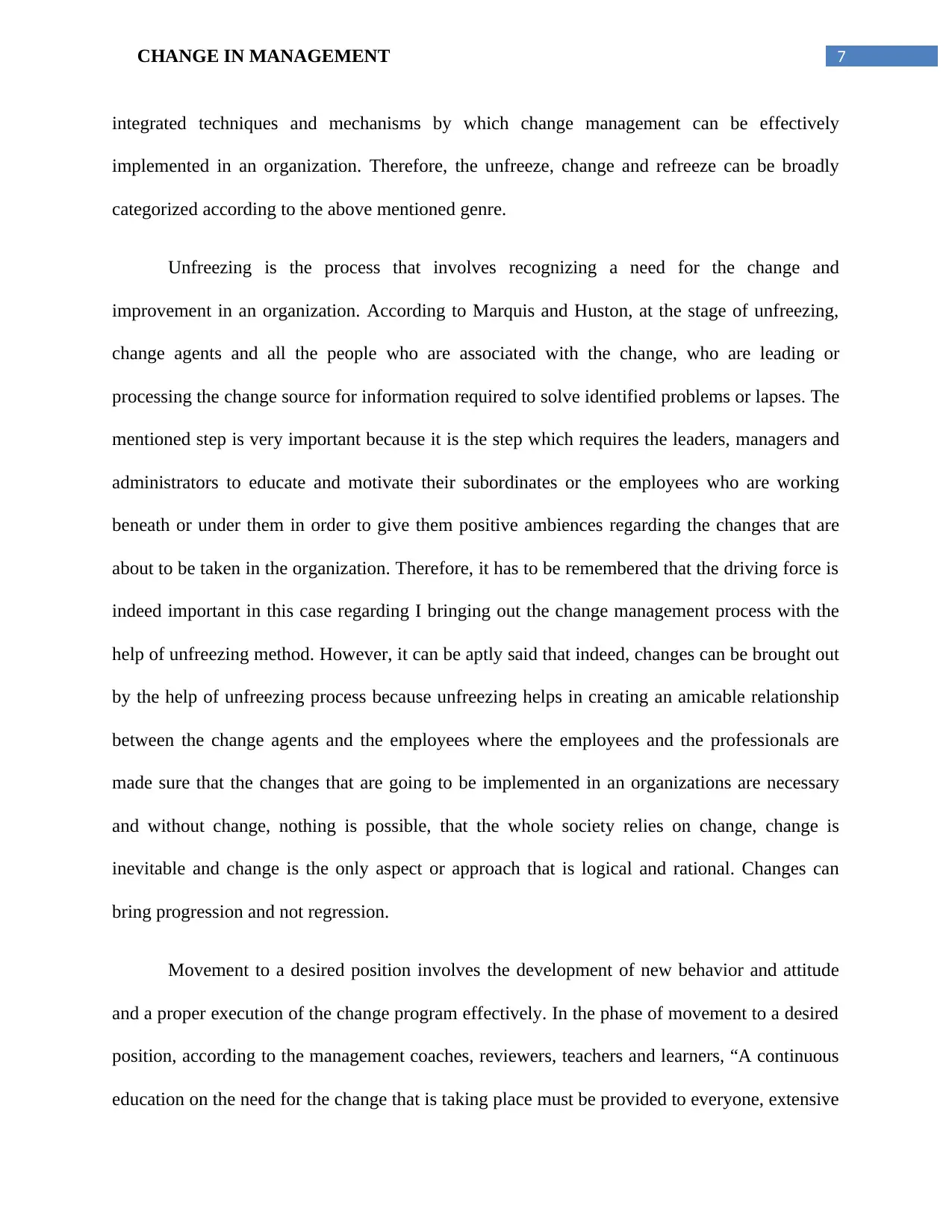
7CHANGE IN MANAGEMENT
integrated techniques and mechanisms by which change management can be effectively
implemented in an organization. Therefore, the unfreeze, change and refreeze can be broadly
categorized according to the above mentioned genre.
Unfreezing is the process that involves recognizing a need for the change and
improvement in an organization. According to Marquis and Huston, at the stage of unfreezing,
change agents and all the people who are associated with the change, who are leading or
processing the change source for information required to solve identified problems or lapses. The
mentioned step is very important because it is the step which requires the leaders, managers and
administrators to educate and motivate their subordinates or the employees who are working
beneath or under them in order to give them positive ambiences regarding the changes that are
about to be taken in the organization. Therefore, it has to be remembered that the driving force is
indeed important in this case regarding I bringing out the change management process with the
help of unfreezing method. However, it can be aptly said that indeed, changes can be brought out
by the help of unfreezing process because unfreezing helps in creating an amicable relationship
between the change agents and the employees where the employees and the professionals are
made sure that the changes that are going to be implemented in an organizations are necessary
and without change, nothing is possible, that the whole society relies on change, change is
inevitable and change is the only aspect or approach that is logical and rational. Changes can
bring progression and not regression.
Movement to a desired position involves the development of new behavior and attitude
and a proper execution of the change program effectively. In the phase of movement to a desired
position, according to the management coaches, reviewers, teachers and learners, “A continuous
education on the need for the change that is taking place must be provided to everyone, extensive
integrated techniques and mechanisms by which change management can be effectively
implemented in an organization. Therefore, the unfreeze, change and refreeze can be broadly
categorized according to the above mentioned genre.
Unfreezing is the process that involves recognizing a need for the change and
improvement in an organization. According to Marquis and Huston, at the stage of unfreezing,
change agents and all the people who are associated with the change, who are leading or
processing the change source for information required to solve identified problems or lapses. The
mentioned step is very important because it is the step which requires the leaders, managers and
administrators to educate and motivate their subordinates or the employees who are working
beneath or under them in order to give them positive ambiences regarding the changes that are
about to be taken in the organization. Therefore, it has to be remembered that the driving force is
indeed important in this case regarding I bringing out the change management process with the
help of unfreezing method. However, it can be aptly said that indeed, changes can be brought out
by the help of unfreezing process because unfreezing helps in creating an amicable relationship
between the change agents and the employees where the employees and the professionals are
made sure that the changes that are going to be implemented in an organizations are necessary
and without change, nothing is possible, that the whole society relies on change, change is
inevitable and change is the only aspect or approach that is logical and rational. Changes can
bring progression and not regression.
Movement to a desired position involves the development of new behavior and attitude
and a proper execution of the change program effectively. In the phase of movement to a desired
position, according to the management coaches, reviewers, teachers and learners, “A continuous
education on the need for the change that is taking place must be provided to everyone, extensive
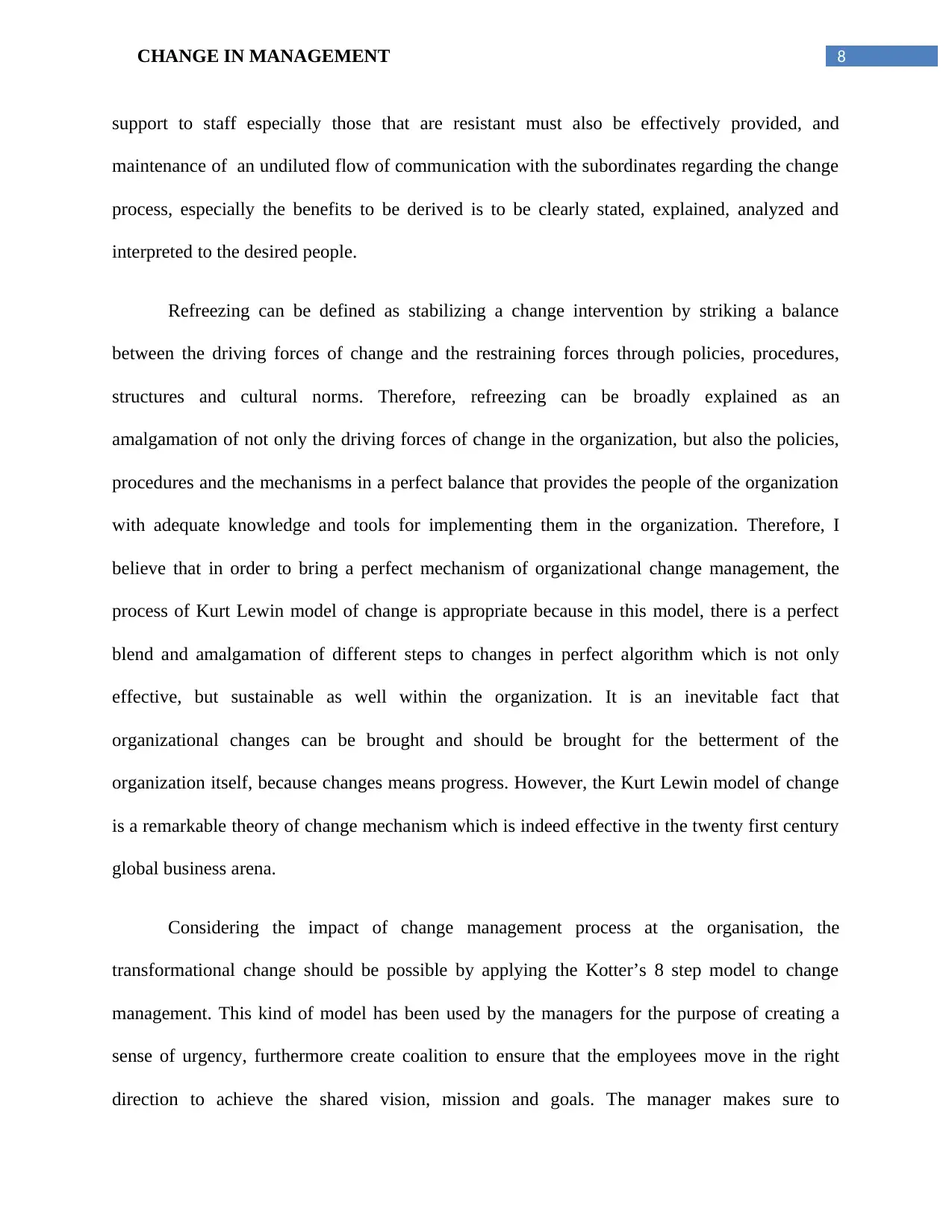
8CHANGE IN MANAGEMENT
support to staff especially those that are resistant must also be effectively provided, and
maintenance of an undiluted flow of communication with the subordinates regarding the change
process, especially the benefits to be derived is to be clearly stated, explained, analyzed and
interpreted to the desired people.
Refreezing can be defined as stabilizing a change intervention by striking a balance
between the driving forces of change and the restraining forces through policies, procedures,
structures and cultural norms. Therefore, refreezing can be broadly explained as an
amalgamation of not only the driving forces of change in the organization, but also the policies,
procedures and the mechanisms in a perfect balance that provides the people of the organization
with adequate knowledge and tools for implementing them in the organization. Therefore, I
believe that in order to bring a perfect mechanism of organizational change management, the
process of Kurt Lewin model of change is appropriate because in this model, there is a perfect
blend and amalgamation of different steps to changes in perfect algorithm which is not only
effective, but sustainable as well within the organization. It is an inevitable fact that
organizational changes can be brought and should be brought for the betterment of the
organization itself, because changes means progress. However, the Kurt Lewin model of change
is a remarkable theory of change mechanism which is indeed effective in the twenty first century
global business arena.
Considering the impact of change management process at the organisation, the
transformational change should be possible by applying the Kotter’s 8 step model to change
management. This kind of model has been used by the managers for the purpose of creating a
sense of urgency, furthermore create coalition to ensure that the employees move in the right
direction to achieve the shared vision, mission and goals. The manager makes sure to
support to staff especially those that are resistant must also be effectively provided, and
maintenance of an undiluted flow of communication with the subordinates regarding the change
process, especially the benefits to be derived is to be clearly stated, explained, analyzed and
interpreted to the desired people.
Refreezing can be defined as stabilizing a change intervention by striking a balance
between the driving forces of change and the restraining forces through policies, procedures,
structures and cultural norms. Therefore, refreezing can be broadly explained as an
amalgamation of not only the driving forces of change in the organization, but also the policies,
procedures and the mechanisms in a perfect balance that provides the people of the organization
with adequate knowledge and tools for implementing them in the organization. Therefore, I
believe that in order to bring a perfect mechanism of organizational change management, the
process of Kurt Lewin model of change is appropriate because in this model, there is a perfect
blend and amalgamation of different steps to changes in perfect algorithm which is not only
effective, but sustainable as well within the organization. It is an inevitable fact that
organizational changes can be brought and should be brought for the betterment of the
organization itself, because changes means progress. However, the Kurt Lewin model of change
is a remarkable theory of change mechanism which is indeed effective in the twenty first century
global business arena.
Considering the impact of change management process at the organisation, the
transformational change should be possible by applying the Kotter’s 8 step model to change
management. This kind of model has been used by the managers for the purpose of creating a
sense of urgency, furthermore create coalition to ensure that the employees move in the right
direction to achieve the shared vision, mission and goals. The manager makes sure to
⊘ This is a preview!⊘
Do you want full access?
Subscribe today to unlock all pages.

Trusted by 1+ million students worldwide
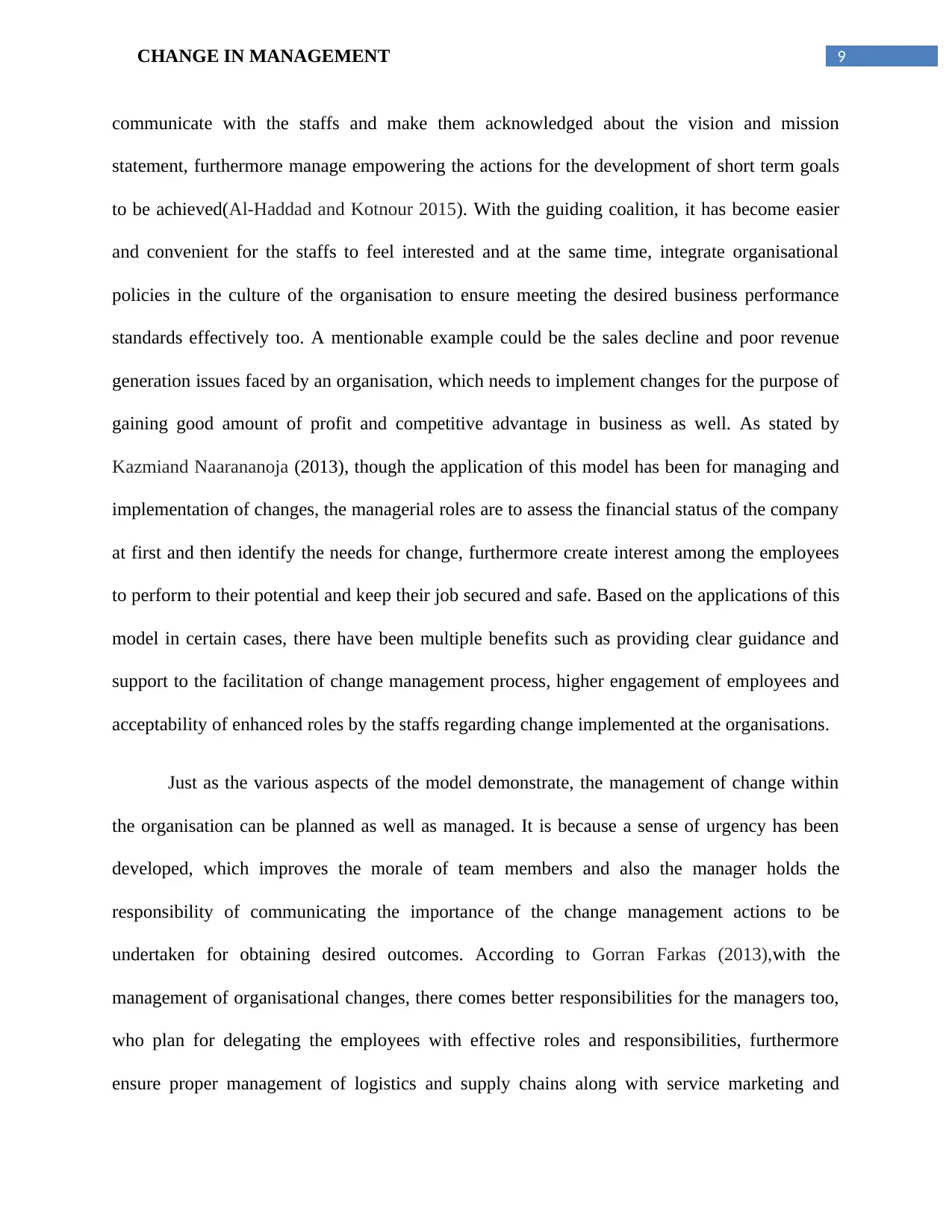
9CHANGE IN MANAGEMENT
communicate with the staffs and make them acknowledged about the vision and mission
statement, furthermore manage empowering the actions for the development of short term goals
to be achieved(Al-Haddad and Kotnour 2015). With the guiding coalition, it has become easier
and convenient for the staffs to feel interested and at the same time, integrate organisational
policies in the culture of the organisation to ensure meeting the desired business performance
standards effectively too. A mentionable example could be the sales decline and poor revenue
generation issues faced by an organisation, which needs to implement changes for the purpose of
gaining good amount of profit and competitive advantage in business as well. As stated by
Kazmiand Naarananoja (2013), though the application of this model has been for managing and
implementation of changes, the managerial roles are to assess the financial status of the company
at first and then identify the needs for change, furthermore create interest among the employees
to perform to their potential and keep their job secured and safe. Based on the applications of this
model in certain cases, there have been multiple benefits such as providing clear guidance and
support to the facilitation of change management process, higher engagement of employees and
acceptability of enhanced roles by the staffs regarding change implemented at the organisations.
Just as the various aspects of the model demonstrate, the management of change within
the organisation can be planned as well as managed. It is because a sense of urgency has been
developed, which improves the morale of team members and also the manager holds the
responsibility of communicating the importance of the change management actions to be
undertaken for obtaining desired outcomes. According to Gorran Farkas (2013),with the
management of organisational changes, there comes better responsibilities for the managers too,
who plan for delegating the employees with effective roles and responsibilities, furthermore
ensure proper management of logistics and supply chains along with service marketing and
communicate with the staffs and make them acknowledged about the vision and mission
statement, furthermore manage empowering the actions for the development of short term goals
to be achieved(Al-Haddad and Kotnour 2015). With the guiding coalition, it has become easier
and convenient for the staffs to feel interested and at the same time, integrate organisational
policies in the culture of the organisation to ensure meeting the desired business performance
standards effectively too. A mentionable example could be the sales decline and poor revenue
generation issues faced by an organisation, which needs to implement changes for the purpose of
gaining good amount of profit and competitive advantage in business as well. As stated by
Kazmiand Naarananoja (2013), though the application of this model has been for managing and
implementation of changes, the managerial roles are to assess the financial status of the company
at first and then identify the needs for change, furthermore create interest among the employees
to perform to their potential and keep their job secured and safe. Based on the applications of this
model in certain cases, there have been multiple benefits such as providing clear guidance and
support to the facilitation of change management process, higher engagement of employees and
acceptability of enhanced roles by the staffs regarding change implemented at the organisations.
Just as the various aspects of the model demonstrate, the management of change within
the organisation can be planned as well as managed. It is because a sense of urgency has been
developed, which improves the morale of team members and also the manager holds the
responsibility of communicating the importance of the change management actions to be
undertaken for obtaining desired outcomes. According to Gorran Farkas (2013),with the
management of organisational changes, there comes better responsibilities for the managers too,
who plan for delegating the employees with effective roles and responsibilities, furthermore
ensure proper management of logistics and supply chains along with service marketing and
Paraphrase This Document
Need a fresh take? Get an instant paraphrase of this document with our AI Paraphraser
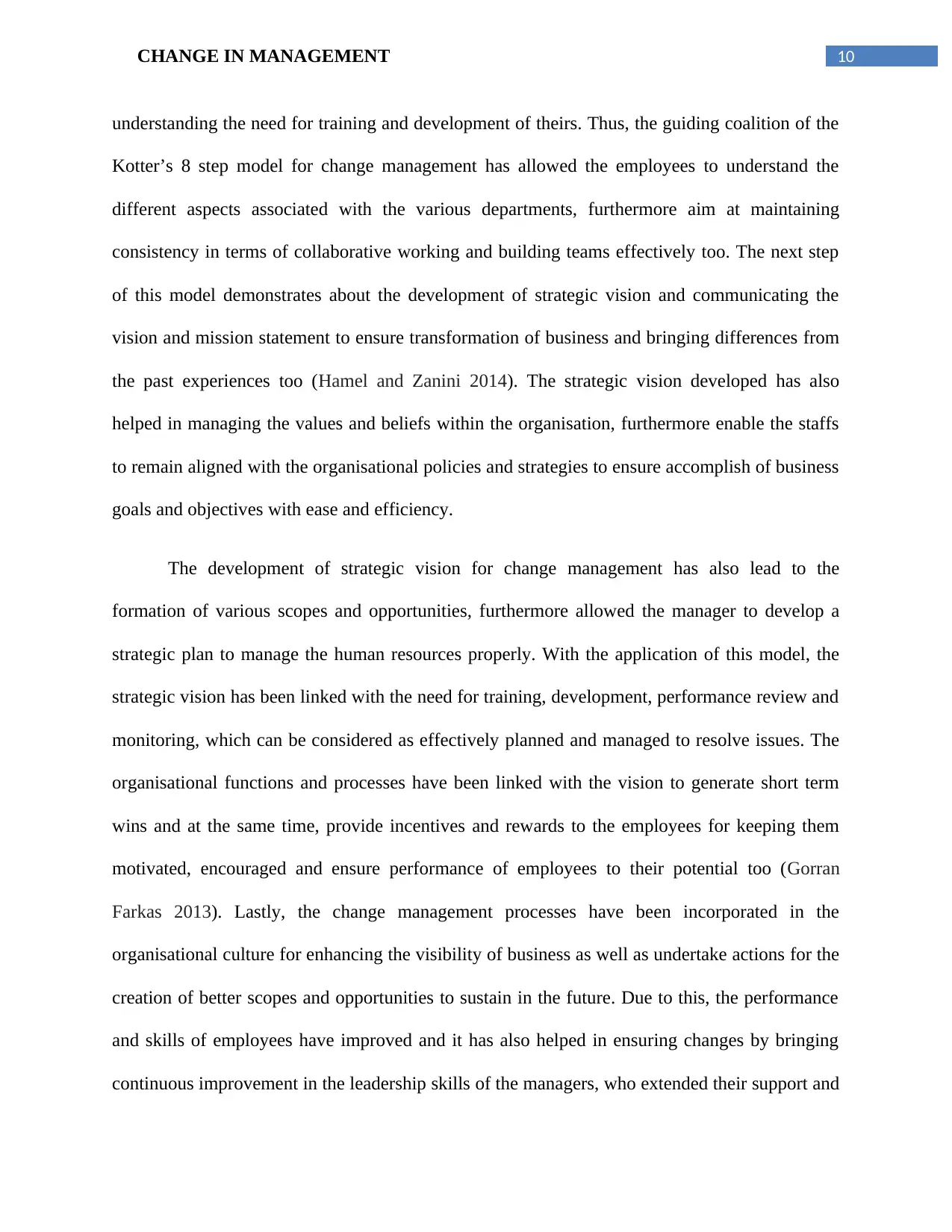
10CHANGE IN MANAGEMENT
understanding the need for training and development of theirs. Thus, the guiding coalition of the
Kotter’s 8 step model for change management has allowed the employees to understand the
different aspects associated with the various departments, furthermore aim at maintaining
consistency in terms of collaborative working and building teams effectively too. The next step
of this model demonstrates about the development of strategic vision and communicating the
vision and mission statement to ensure transformation of business and bringing differences from
the past experiences too (Hamel and Zanini 2014). The strategic vision developed has also
helped in managing the values and beliefs within the organisation, furthermore enable the staffs
to remain aligned with the organisational policies and strategies to ensure accomplish of business
goals and objectives with ease and efficiency.
The development of strategic vision for change management has also lead to the
formation of various scopes and opportunities, furthermore allowed the manager to develop a
strategic plan to manage the human resources properly. With the application of this model, the
strategic vision has been linked with the need for training, development, performance review and
monitoring, which can be considered as effectively planned and managed to resolve issues. The
organisational functions and processes have been linked with the vision to generate short term
wins and at the same time, provide incentives and rewards to the employees for keeping them
motivated, encouraged and ensure performance of employees to their potential too (Gorran
Farkas 2013). Lastly, the change management processes have been incorporated in the
organisational culture for enhancing the visibility of business as well as undertake actions for the
creation of better scopes and opportunities to sustain in the future. Due to this, the performance
and skills of employees have improved and it has also helped in ensuring changes by bringing
continuous improvement in the leadership skills of the managers, who extended their support and
understanding the need for training and development of theirs. Thus, the guiding coalition of the
Kotter’s 8 step model for change management has allowed the employees to understand the
different aspects associated with the various departments, furthermore aim at maintaining
consistency in terms of collaborative working and building teams effectively too. The next step
of this model demonstrates about the development of strategic vision and communicating the
vision and mission statement to ensure transformation of business and bringing differences from
the past experiences too (Hamel and Zanini 2014). The strategic vision developed has also
helped in managing the values and beliefs within the organisation, furthermore enable the staffs
to remain aligned with the organisational policies and strategies to ensure accomplish of business
goals and objectives with ease and efficiency.
The development of strategic vision for change management has also lead to the
formation of various scopes and opportunities, furthermore allowed the manager to develop a
strategic plan to manage the human resources properly. With the application of this model, the
strategic vision has been linked with the need for training, development, performance review and
monitoring, which can be considered as effectively planned and managed to resolve issues. The
organisational functions and processes have been linked with the vision to generate short term
wins and at the same time, provide incentives and rewards to the employees for keeping them
motivated, encouraged and ensure performance of employees to their potential too (Gorran
Farkas 2013). Lastly, the change management processes have been incorporated in the
organisational culture for enhancing the visibility of business as well as undertake actions for the
creation of better scopes and opportunities to sustain in the future. Due to this, the performance
and skills of employees have improved and it has also helped in ensuring changes by bringing
continuous improvement in the leadership skills of the managers, who extended their support and
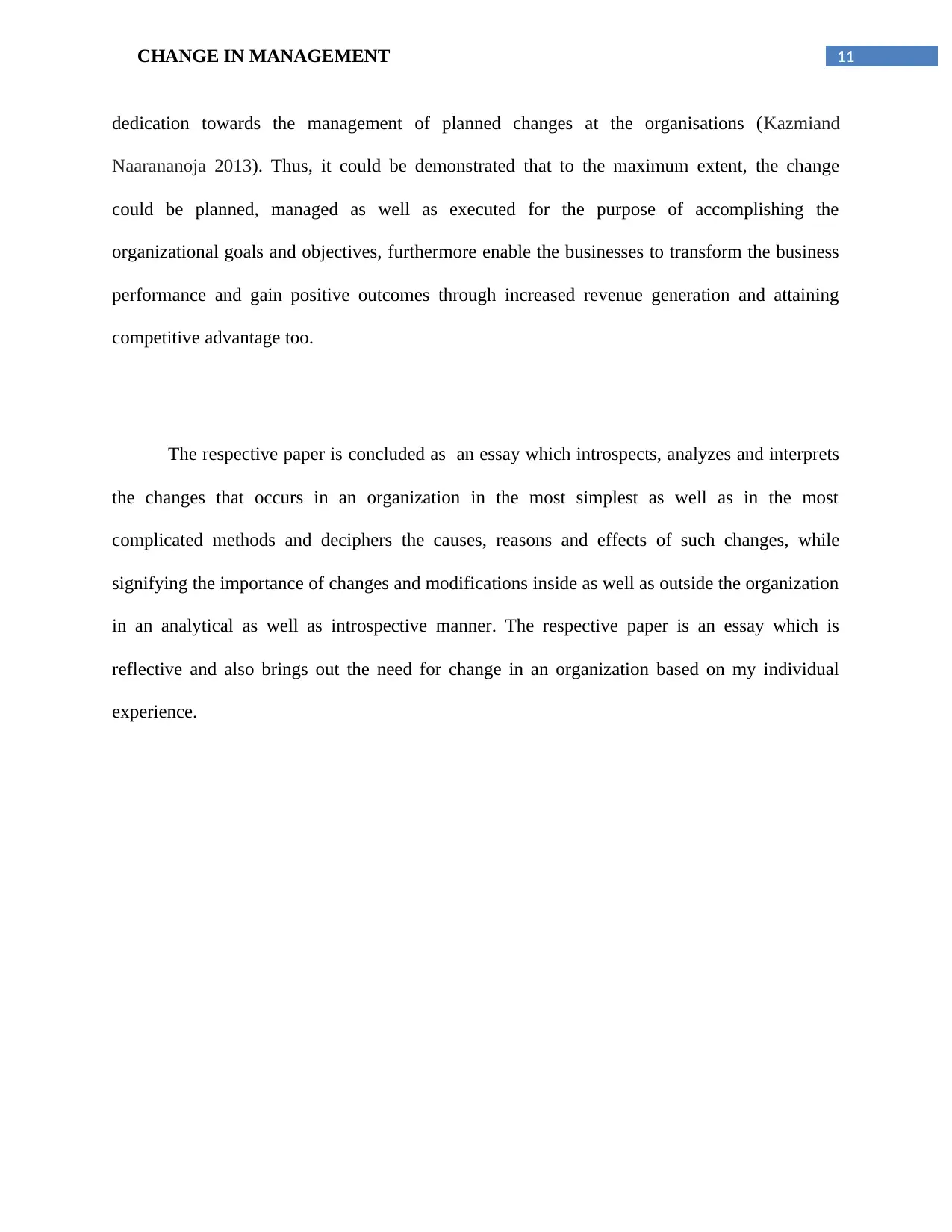
11CHANGE IN MANAGEMENT
dedication towards the management of planned changes at the organisations (Kazmiand
Naarananoja 2013). Thus, it could be demonstrated that to the maximum extent, the change
could be planned, managed as well as executed for the purpose of accomplishing the
organizational goals and objectives, furthermore enable the businesses to transform the business
performance and gain positive outcomes through increased revenue generation and attaining
competitive advantage too.
The respective paper is concluded as an essay which introspects, analyzes and interprets
the changes that occurs in an organization in the most simplest as well as in the most
complicated methods and deciphers the causes, reasons and effects of such changes, while
signifying the importance of changes and modifications inside as well as outside the organization
in an analytical as well as introspective manner. The respective paper is an essay which is
reflective and also brings out the need for change in an organization based on my individual
experience.
dedication towards the management of planned changes at the organisations (Kazmiand
Naarananoja 2013). Thus, it could be demonstrated that to the maximum extent, the change
could be planned, managed as well as executed for the purpose of accomplishing the
organizational goals and objectives, furthermore enable the businesses to transform the business
performance and gain positive outcomes through increased revenue generation and attaining
competitive advantage too.
The respective paper is concluded as an essay which introspects, analyzes and interprets
the changes that occurs in an organization in the most simplest as well as in the most
complicated methods and deciphers the causes, reasons and effects of such changes, while
signifying the importance of changes and modifications inside as well as outside the organization
in an analytical as well as introspective manner. The respective paper is an essay which is
reflective and also brings out the need for change in an organization based on my individual
experience.
⊘ This is a preview!⊘
Do you want full access?
Subscribe today to unlock all pages.

Trusted by 1+ million students worldwide
1 out of 14
Related Documents
Your All-in-One AI-Powered Toolkit for Academic Success.
+13062052269
info@desklib.com
Available 24*7 on WhatsApp / Email
![[object Object]](/_next/static/media/star-bottom.7253800d.svg)
Unlock your academic potential
Copyright © 2020–2025 A2Z Services. All Rights Reserved. Developed and managed by ZUCOL.





